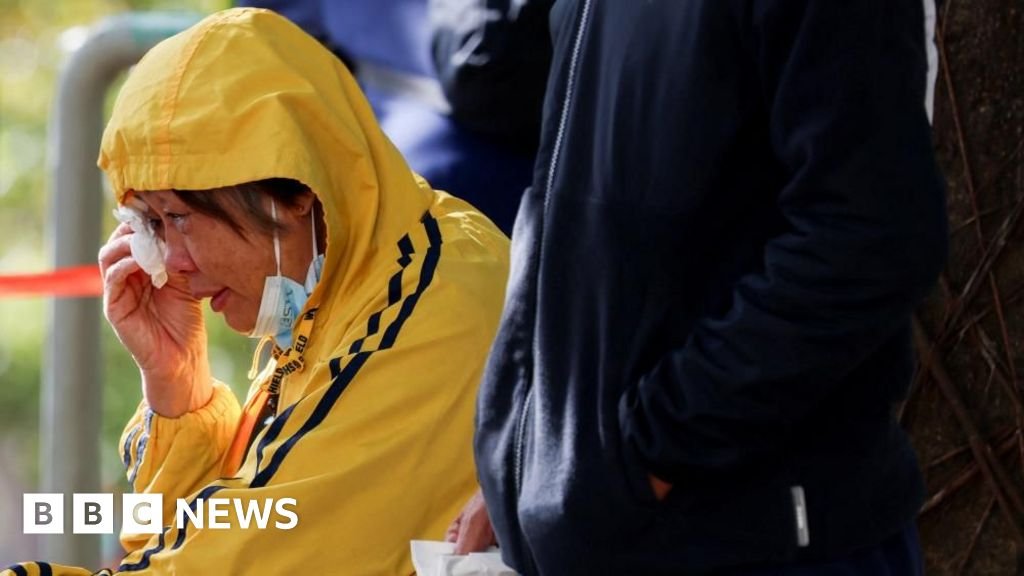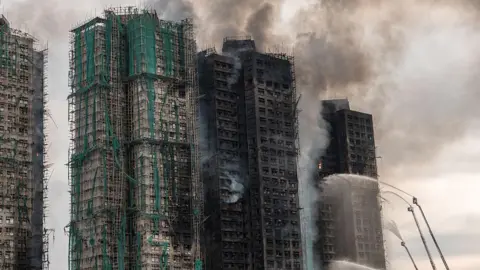
Hong Kong Fires: Anger and Unanswered Questions
A massive fire in a densely populated subsidized housing estate has sparked outrage in Hong Kong on Wednesday, killing at least 128 people and seriously injuring dozens.
The fire, which raged for more than a day, may have been fueled by shoddy netting and plastic sheets on the buildings’ windows, officials said.
Firefighting operations have now ended, with dozens of residents still missing.
Many questions are being raised as to how the fire at Wang Fook Court spread so quickly and who is responsible for it. “Man-Made Disasters”.
Three men who renovated the blocks have been arrested on manslaughter charges and authorities have launched a corruption probe.
A post that went viral on social media in the wake of the fire read: “This is no accident.”
Several residents have revealed in interviews that the fire alarm did not go off when the fire broke out. Officials said Friday they checked the fire alarms in all eight blocks and found they were not working properly.
Kiko Ma, who owns an apartment at Wang Fook Court, says the alarm was set off during renovation work, as construction workers regularly used fire escapes to enter and exit the building.
Ms. Ma lives in Canada with her family, but visits the Hong Kong apartment several times a year.
“It was avoidable… a lot of people didn’t do their duty,” the 33-year-old tells the BBC, claiming the renovation firm used “poor quality, flammable materials”.
Residents often saw construction workers smoking and found cigarette butts on their windowsills, she adds.
“People were asking what would happen if there was a fire. Everyone was very worried.”

 Getty Images
Getty ImagesIt is Hong Kong’s deadliest fire in at least 63 years – already surpassing the August 1962 fire in the Sham Shui Po neighborhood, which killed 44 people and displaced hundreds.
Built in the 1980s, Wang Fook Court in Hong Kong’s northeastern Tai Po district consists of eight 31-story buildings, seven of which were destroyed in the fire. Flats here are sold at subsidized prices, but the day-to-day affairs of the estate are managed by a privately appointed firm.
As of the 2021 census, about 4,600 people live in the complex – nearly 40% of whom are 65 or older.
The city’s fire department said Thursday that firefighters faced major challenges in trying to rescue residents, including high temperatures, the risk of further scaffolding collapse and the apartment’s small and crowded interior.
Hong Kong is famous for its small, dense inner-city housing, where many public rental housing tenants have an average living space of just 14.1 square meters.
It is unclear how many people were in Wang Phuc Court when the fire broke out, but according to recent census figures, there are about 4,600 residents. Hundreds of them have been moved to temporary shelters and some are being allocated emergency housing units.
Police are investigating whether the mesh, plastic and canvas sheets used during the renovation meet fire safety standards. In a presser Friday, he attributed the fire’s rapid spread to Styrofoam blocks placed outside the apartment windows, apparently “protecting” them from debris and dust.
Some experts believe that the bamboo scaffolding connecting the apartment blocks helped start the fire. Such scaffolding is an iconic sight throughout Hong Kong and is widely used in construction.
Earlier this year, officials announced plans to phase out bamboo in favor of stronger, fire-resistant steel, citing its flammability and deterioration over time.

 Getty Images
Getty ImagesResidents of Wang Fook Court expressed their displeasure at the announcement of renovation plans last year. Reports of those concerns have now resurfaced online, with accusations of a lack of transparency.
Another homeowner who was overseas when the fire broke out said the plans were “fundamentally bleak”.
“(Officials) used small favors to encourage skeptical elderly residents to support their plans,” he wrote in a comment on Instagram.
Mr Lai, a sales associate who agreed to be quoted by the BBC only by his last name, says residents of Wang Fook Court have previously questioned the high cost of renovation works.
Appeals by some residents to re-elect the estate’s management committee were ignored, he added. This week’s fire was not an isolated incident, Mr Lai said, claiming construction companies “too often prioritize cost efficiency” over safety.
He noted that a fire broke out last month when bamboo scaffolding of a building in Hong Kong’s central district caught fire.
“When similar incidents occur, they raise the question of whether (there are) systemic weaknesses.”
Hong Kong authorities on Thursday ordered inspections of all housing estates undergoing “major repairs” to check the “safety of scaffolding and construction materials”.













Post Comment